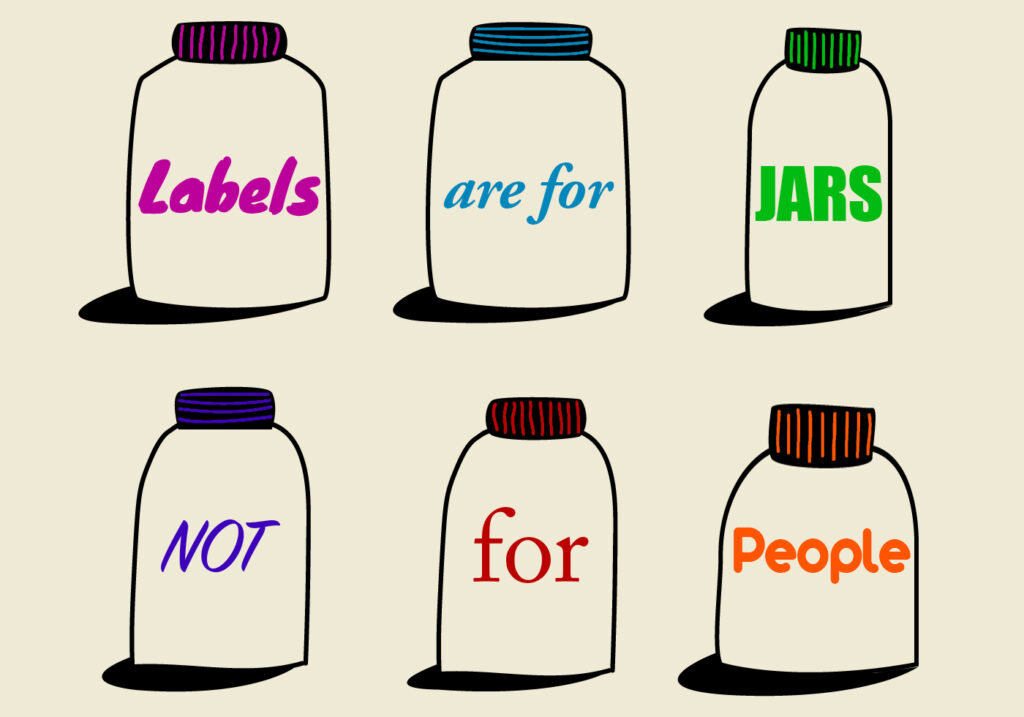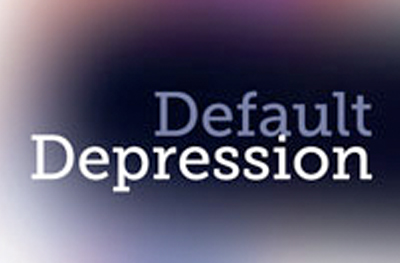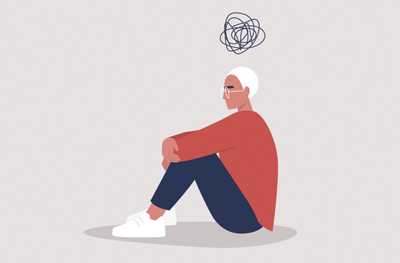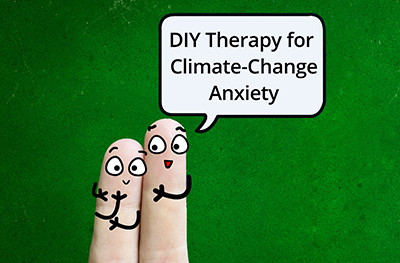Labels are for Jars not for People examines choosing language that helps rather than harms people experiencing psychological distress written by Dr. John Ashfield, PhD
Mental health, the new buzz words of modern society.
Historically, there have been various ways of characterising difficult, challenging, and intensely disruptive human experience and its accompanying behavioural reactions and responses. We have certainly come a long way since the days when little understood psychological states and behaviours were met with fear, sometimes consequenting severe remedies and even incarceration. But let’s not think that we are so far removed from the harshness and cruelty of past practices, that we have greatly advanced in general. Unfortunately, though we have moved beyond some of the pseudo-science (and crude treatments) of the past, we still haven’t disentangled ourselves from some of its language and the tendency to dress up ignorance and speculation as science.
The term mental health, now commonplace in our cultural vocabulary and simply taken for granted, by implying and in fact supporting the existence of its opposite, mental illness, lures us into a dark past of spurious practices and unwarranted attitudes. Thus, what sounds harmless is actually far from it, despite being comfortably accommodated in common parlance.
The terms mental health, mental illness, and mental disorder, being language in medical use, suggest that mental (in association with health, illness, or disorder) is or at least resembles an observable organic entity that can be examined for illness or disease, thus providing a sound basis for medical diagnosis and treatment. In reality, this is not even a defensible use of analogy. Little wonder then, that some doctors have been known to refer to their colleagues in psychiatry as practitioners of ‘the dark arts’, especially when they prescribe powerful psychiatric medications in the absence of any biomarkers or evidence indicating any kind of illness or disease process at all. However, the real scope of this problem is most prevalent in general medical practice, where most diagnoses and prescriptions for presumed mental ill-health or disorder are issued in the context of pressured and quite brief medical consultations. To properly address this problem is beyond the scope of this article, however, it needs to be mentioned and understood as part of a wider tendency of both the mental health system and primary care medical practice.
Some people (in fact many people) experience states of thought, emotion, physiology, and behavioural reactivity, which involve intense suffering, and high levels of distress. These are all part of the human condition and experience we share in common. Yet, how these should be described and addressed is deserving of the most efficacious, respectful, and potentially restorative approach available. In all of this, the language we choose to employ can be decisive.
Alas, the term mental health is so entrenched in Western cultures, we will for now have to grudgingly accommodate it and try our best to work around it, until psychiatry as a discipline is prepared to engage with some awkward questions, and a genuine endeavour of reform.
The origin of mental illness stigma.
How often are we told that our mental health system is in crisis and needs more funds? Yet, one of the ironies and inexplicable contradictions of this system is its expenditure of public funds ostensibly to remove the stigma created by the very language and clinical labels its own practitioners nonchalantly apply to their ‘patients’.
Language and labels, such as ‘mental disorder’ and ‘mental illness’, or one of the numerous diagnostic terms with which disorder is coupled like, generalised anxiety disorder, premenstrual dysphoric disorder, or depressive disorder, may seem innocuous, but in fact, they can be quite derogatory and harmful to the individual. Moreover, these labels are most often applied in haste without proper reference to any standard diagnostic criteria (even if such criteria were a reliable measure, which they are not), due to the in and out the door quickly practice now predominant in primary care medicine.
Though it must be acknowledged that not infrequently it is patient’s themselves who pressure GPs for a diagnosis and quick pharmaceutical solution to what is in many cases a situational, lifestyle, or interpersonal problem (rather than medical problem), it is still the doctor that documents a medical diagnosis and signs off on a prescription. Of course, many GPs are trying to practice medicine in a more patient centred way, but they are battling entrenched practices and growing bureaucratic and administrative demands that make this exceedingly difficult. Nevertheless, it is possible to adopt language that helps rather than harms, to refer patients for non-medical psychological support, and to say no to requests for medication that is not indicated or necessary.
The medicalisation of common human experience.
The number of people in our community now being diagnosed with and medicated for a mental illness or disorder, poses a major challenge for our already overburdened primary care and mental health services and the funding required to sustain them. Depression and anxiety (the predominant and highest prevalence diagnoses) have apparently reached record levels. We are told by the mass media and our major mental health institutions that these are one of the major health challenges of our generation. The question is: what is so badly amiss with Western society that should occasion such an historically unprecedented decline in people’s psychological wellbeing? One must begin to wonder why humanity has suddenly taken such a turn for the worse. Clearly, the psychiatric/medical remedy applied to this problem is a failed enterprise, with the reported prevalence of ‘mental illness’ being unremitting in its escalation.
Are we really succumbing to a pandemic of mental illness, or is there another explanation for what is happening? Well, what so many ordinary citizens (non-mental health professionals) have suspected for some time, actually goes right to the heart of the matter: that perhaps there is a problem with the way we have come to define and respond to personal distress – including psychological and emotional difficulties, which previously would not have been the domain of medical intervention and diagnosis, and would have been largely resolved with various forms of non-medical human support.
With some closer analysis of the mental health ‘industry’, what we discover, contrary to what we have been told so often, is not a crisis of mental ill-health at all, but the effects of a deeply flawed narrative of ‘mental illness’ and ‘disorder’, directly related to the systematic medicalisation of common human experience. Put simply, a whole gamut of common, albeit sometimes very challenging and disconcerting human experience, has been corralled by medicine (and its specialty of psychiatry) and referred to as illness or disorder; and where there is illness, treatments and especially drugs are utilised to attempt to cure it. Unfortunately, the common medical reflex when presented with a person disclosing psychological distress is to apply a diagnostic label and to provide a script for medication.
How the medicalisation of common human experience now fits hand in glove with popular culture.
‘A smooth sea never made a good sailor’
Hilaire Belloc
Do any of us have an easy passage through life? It would seem that popular culture sees this as an entitlement, and one which someone else must accommodate and pay for. Even if it were possible to settle in free of charge in mum and dad’s basement, ‘wrapped in cotton wool’ for years on end, life’s challenges and tough realities are eventually and inevitably inescapable. A truism of life is: ‘you may run but you can’t hide’.
The elective fragility of modern culture (principally in the younger generation) opting for avoidant escapism and demanding safe spaces and trigger warnings, is not going to end well, not the least reason being because it finds an easy passage into a medical and mental health system more than willing to accommodate it with one of numerous diagnoses for common human experience. This system often provides open arms to those wanting to avoid the rough and tumble of life and its threat to their cultivated hypersensitivity. They will welcome labels which confirm the cruel effects of life, that these effects need to be chemically sublimated and modified, and that they as affected individuals should be allowed to withdraw from normal interpersonal and social responsibilities. The consequence of this collusion is an erosion of emotional resilience, declining psychological wellbeing, and a shrinking fitness for engaging with life and normal social responsibilities.
There is a high price to be paid for opting out of and avoiding important and necessary exposure and adaptation to life’s realities, including a huge burden of cost on families, social systems of essential support, on employers, and providers of employment insurance.
Labels of illness and disorder have many ‘knock on’ effects.
‘Language is not just descriptive it is transformative; it creates what didn’t exist before’.
Language and labels of disorder and illness don’t merely create stigma (redefining an individual in a negative way in the eyes of others), they often transform the way individuals come to see and define themselves, sometimes for a lifetime. In technical terms, this is best described as ‘clinical iatrogenesis’, meaning: harm done by the very professionals whom one has trusted to do no harm. Prescribed medication added to the equation, daily suggestive of illness, potently and repeatedly reinforces and confirms the individual’s ‘clinical’ condition. Since many patients do not have their medication periodically reviewed for its efficacy, sometimes for years, they assume that their illness/disorder is a chronic condition, like a chronic physical disease. Discussion of recovery in many cases never occurs. It shouldn’t surprise us to discover that one of the most lucrative money spinners for big pharmaceutical companies has been antidepressants.
Let’s not forget either that, labels have potential practical consequences (which then impact on the individual psychologically and socially). An insurance application may require declaration of a mental disorder label, which if provided may also have cost or exclusionary consequences. Individuals with a mental illness or disorder label may be excluded from certain forms of employment. These are no small matters.
You might well ask, what ever happened to the idea of restorative psychotherapy? Well, if you track the history and developments in psychiatry, you will detect an almost complete shift away from psychotherapy that aimed for a patient’s recovery, to dependence on psychotropic medications to treat them. Given that such treatments are largely palliative, that is, they treat symptoms only, without any real impetus for return to normal non-drug dependent functioning, one has to question the validity of the whole psychiatric enterprise, particularly given that by far the majority of so called ‘mental health disorders’ are in fact quite amenable to a return to normal functioning by addressing situational stressors, modification of lifestyle, and yes, if need be, psychotherapy.
How we as a society have ended up in this absurd position requires a long and complex explanation beyond the scope of this article. However, what can be said is that we are not powerless as individuals to at least question and decide what we are prepared to put up with within the scope of our own family and friendship group, and within our professional practice. We can question, we can challenge, and we can refuse to accept or apply labels whether in medical records or in other ways.
Can using labels be justified?
There are those who defend the language and labels used in the way that has been described, by arguing that many people find it a relief, at least initially, to be given an official diagnosis and a name for an experience they have found so difficult. However, this is misleading and misguided, when merely providing a succinct description of a difficulty being experienced (without the need of labelling) using clear non-medicalising language is just as reassuring, yet without any adverse negative effects for the patient.
Not surprisingly, parents may feel relieved when problems they are encountering in their children are diagnosed and labelled – especially the kind of problems that attract disapproval from other parents or that have them feeling inadequate or like they are bad parents. Teachers too may favour labelling because it can provide a reason for a child’s learning difficulties or hard to manage behaviours.
The kind of labels that are now commonly being applied to children and teenagers with often uninformed guesswork, such as ADHD, ADD, Asperger’s, and now popularly, ‘he/she is probably on the autism spectrum’, have real consequences that can quickly negate any short-term feelings of relief or validation for parents and teachers. Users of these labels may feel and sound more in control of what they are struggling to deal with, but what of the potential long-term consequences for those to whom such labels are applied?
‘Labels can negate both the necessity and opportunity for an individual to rise above expectation’.
It is frequently the case that children and teenagers will actively adapt and live up to the labels they are given: “Oh, I’m ADD” or, “I’m Asperger’s” can provide licence for unrelenting negative behavioural choices, and retarded adaptation. Such labels can also negate both the necessity and opportunity for an individual to rise above expectation. Of course, we do not want to return to the cruelty of former ages when people who were different or difficult were treated badly or ostracised. Our starting point in human relations and societal responsibility must always be one of intelligent compassion. Notwithstanding, we do children and teenagers no favours by not confronting them with the necessity to work as hard as they must and can within their real capacity (not a capacity suggested by a label) to adapt to the mainstream responsibilities and demands of human community. Yes, they may have to work a good deal harder to accomplish this than their peers do, yet they must be given every opportunity to do so for their own wellbeing.
This is not to trivialise at all how difficult it can be to parent or teach children with severe difficulties of adjustment, learning, or behaviour; it is to assert that negative labelling most often simply makes things worse.
With little thought and imagination, it is possible for parents, teachers, and mental health professionals to forego labels and instead use containers of explanation (for children, teenagers, and adults) such as: adjustment challenges, situational distress, anxiety behaviours, mood disruption, exaggerated threat sensitivity, psychological distress, reactive vulnerabilities, behavioural challenges, modifiable personality or behavioural traits, or cluster of partially malleable traits. This is not the same as using euphemisms which aim to overly generalise or dilute the reality of things, it is to avoid using categorical labels that often prove to be wrong, that merely make things worse, that provide no prospect of improvement or progress in a positive direction, and do not contain detailed explanations that are of practical benefit.
Of particular usefulness is the term situational distress (mentioned above as a useful container of explanation), which has been defined as: ‘…encompassing a significantly challenging or troubling mixed experience of mind, thoughts, emotions, bodily sensations, or behaviours, most often associated with an apparent challenging or decompensating life event, such as bereavement, a change in health status, relationship breakdown, financial, or occupational difficulties. This distress may significantly overlap with many of the symptoms usually taken to suggest mental ‘illness’ or ‘disorder’ (such as those associated with affective difficulties of depression and anxiety). Even when distress is sometimes inexplicable, a situational approach discourages any presumption of illness or disorder’*
Make no mistake, professionals are influenced by labels.
Labelling can definitely influence how professionals view and deal with patients and clients. On receiving a referral or reading a patient’s or client’s notes, professionals are often primed with bias (despite their best efforts at resisting this). As they say, ‘mud sticks’. Unfortunately, this can taint the perception and direction taken by assessing professionals to whom adults, children and teenagers are referred. I can remember a classic case of this I encountered in my own work with an adult patient. She had undergone unsuccessful treatment for pain control for a condition that was never properly diagnosed. Each entry in her clinical record increasingly insinuated that her problem might be psychological (in the absence of a clearly or conventionally diagnosable physical condition). As a result, professionals to whom she was referred where influenced by this developing narrative until she was eventually seen as needing psychiatric treatment. What then occurred was a chain of handballing from one frustrated psychiatrist to another, until she had amassed eleven different psychiatric diagnoses. Eventually, she was hospitalised with intractable pain and abdominal distension resulting in a different approach to her clearly physical condition and treatment which saw her stabilised and her pain under control. She was subsequently found to exhibit no symptoms nor meet any sensible criteria of mental illness or psychiatric disorder. Sadly, this is one of many cases of misdiagnosis and clinical iatrogenesis I have encountered.
What are we to do?
As already stated, we are not powerless as individuals to at least question and decide what we are prepared to put up with within the scope of our own family and friendship group. We can question, we can challenge, and we can refuse to accept labels whether in medical records or in other ways people might try and apply them.
For those of us in professional practice, we can learn to abstain from labelling, and instead use thoughtfully constructed terms – containers of explanation, which avoid stigma, encourage recovery, or at least encourage potential for significant improvement in our clients dealing with any of the broad spectrum of human experiential and psychological difficulties. Ditch the terms disorder and illness, we don’t need to use them. Yes, we’ll forget sometimes, and it does take a bit of practice to adopt a new habit and mode of expression, but it is well worth it. Incidentally, it even feels better to take an affirmative approach by expecting good things of people and inspiring them to have aspirations of recovery, adaptation, and development.
* Ashfield, J., Macdonald, J., Francis, A. and Smith, A. “A ‘Situational Approach’ to Mental Health Literacy in Australia”. (2017): n. page. Web. 30 May 2017. https://doi.org/10.25155/2017/150517
You can read more on this issue in this book by Anthony Smith






